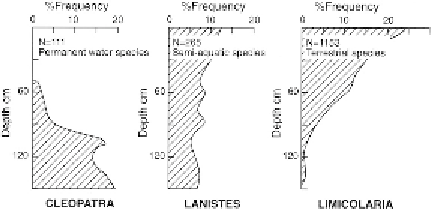Geoscience Reference
In-Depth Information
Figure 16.4. Changes in the proportions of aquatic, semi-aquatic and terrestrial snails
in Gezira clay, lower Blue and White Nile valleys, central Sudan, between 15 and
5 ka. (After Williams et al.,
1982
, fig. 9.8A.)
valuable information about the ecological requirements of particular species, which
has been applied to reconstruct the paleoecology of the Holocene lakes at Adrar Bous
in the central Sahara (Williams et al.,
1987
) and at Erkowit mist oasis in the Red Sea
Hills of eastern Sudan, which enjoyed a less arid climate 2,000 years ago (Mawson
and Williams,
1984
). Indeed, the combined mollusc and ostracod faunas show that
now ephemeral stream channels in the Red Sea Hills were previously perennial and
flowed through swampy meadows, which also, according to the contemporary Sicilian
historian Diodorus, provided a refuge for local cattle rustlers (Mawson and Williams,
1984
).
Tothill (
1946
;
1948
) used the presence of shells of aquatic mollusca to demonstrate
that late Quaternary floods from the Blue Nile had originally deposited the dark
vertisolic clays of semi-arid central Sudan. Williams et al. (
1982
) analysed the primary
shell data obtained by Tothill and plotted the number of mollusc species against depth
to show that the permanent water species
Cleopatra bulimoides
was progressively
replaced by the semi-aquatic species (with gills and lungs)
Lanistes carinatus
,which
was in turn replaced by the terrestrial snail
Limicolaria flammata
some 5,000 years
ago (
Figure 16.4
). Because
Cleopatra
is a mollusc needing permanent water, its
distribution across the Gezira and its vertical distribution in the Gezira soil suggest
extensive areas of permanent water and seasonal flooding in the eastern Gezira. Both
juveniles and adults are present in the clay soil, which led Tothill (
1946
)toinfer
temporary flooding each year, followed by the drying out of the water and mass
death of all age groups.
Cleopatra
occupied an area at least 180 km long and nearly
50 km wide during the very wet climatic interval between 15 ka and about 9 ka
ago (
Figure 16.5
). As the climate became less wet, the extent of seasonal flooding
diminished. Amphibious mollusca, such as
Lanistes
and
Pila wernei
, could survive
in the mud and remain moist until the next annual flood. Once the Blue Nile began
to cut down into its flood-plain from about 8 ka onwards, the distributary channels
responsible for the widespread seasonal flooding would have been beheaded and
deprived of any further water. Flooding had ceased by 6-5 ka, although the climate was

